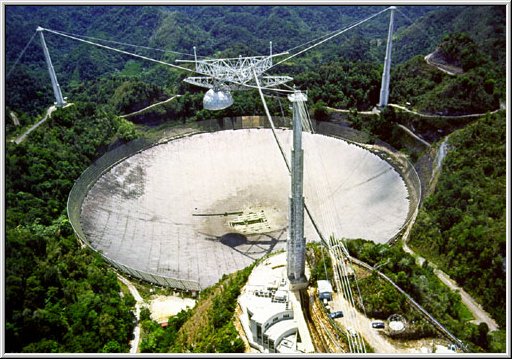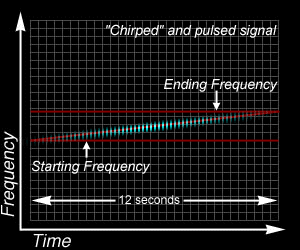

Cosmic signals with a natural origin, which a radio telescope recieves,
are broadband signals. By way of contrast the search of SETI@home assumes
that hypothetical sicnals of an extraterrestrial civilisation are narrowband
signals which have a pulse structure. Furthermore they will have a Doppler
drift resulting from the motion of the earth and of the source of the signals.
 |
 |
The data analysis of the screensaver program decomposes the radio telescope data into narrowband channels by means of fast Fourier transforms. SETI@home uses 15 different Fourier transforms that allow 15 different frequency resolutions given by the formula fn = 0.075 * 2n Hz , n = 0,...,14. Furthermore all data have to be corrected for hypothetical Doppler drift of the signals. SETI@home uses Doppler drift rates between -50 Hz/sec and 50 Hz/sec in steps of 0.02 Hz/sec. Thus SETI@home carries out 5000 calculations for 5000 Doppler drift rates to analyze the data. This leads to high costs in calculation time and to the necessity to use the power of a large number of distributed computers.
For all the above frequency resolutions and drift rates SETI@home analyzes the given radio telescope data and searches for the following 4 types of signals:
| Spikes | Spikes are just points, where the signal is much stronger than the random noise. SETI@home examines the data for signals that exceed 22 times the mean noise power. |
| Gaussian | Gaussians are signals that go up and down as the telescope moves across the sky. As a radio source drifts through the field of view of the telescope, the measured power will vary depending on the telescope's beam profile, which is approximately Gaussian. The SETI@home program examines the data for signals that have a Gaussian behaivior and match the telescope's beam parameters. |
 |
|
| Triplet | A triplet is a type of a pulsed signal. The triplet finder of the program searches the data for three evenly spaced signals that each exceed 7.75 times the mean noise power Obviously such a structure is a good candidate for a signal with a non-natural origin. |
 |
|
| Pulse | Pulses are signals which seem to repeat themselves at constant intervals. These signals can be far less powerful than those needed for triplets. A folding algorithm divides the data into chunks of duration equal to the period being searched and co-adds them to improve signal-to-noise ratio. An FFA performs this function on a large number of periods without duplicating additions. The program computes the threshold for detecting a pulsed signal dynamically to match the number of co-added samples. (I am in the dark about some details of this procedure, however, I could not find a better explaination of the algorithm in the texts on the SETI@home Page.) |
 |
The complete procedure that the screensaver carries out can be described by the following pseudo-code:
| for Doppler drift rates from -50 Hz/s
to +50 Hz
{ for bandwidths from 0.075 to 1220 Hz in 2X steps { Generate time ordered power spectra. Search for short duration signals above a constant threshold (spikes) for each frequency { Search for faint signals matching beam parameters (Gaussians) Search for groups of three evenly spaced signals (triplets) Search for faint repeating pulses (pulses) } } } |
References
| Back to the page of SETI@home results |
| Bernd Fiedler, 10.09.2022 |